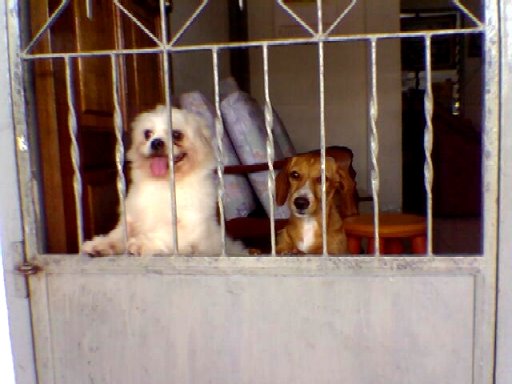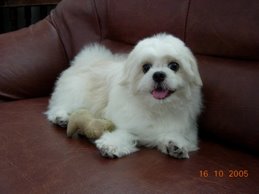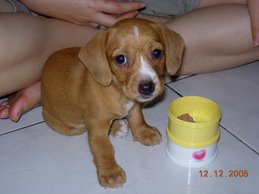When Dogs Scratch Themselves
It is heart-breaking for dog owners who care about their pets to watch them scratching incessantly. Itchy skin can become such an annoyance that a dog will pull all its hair out of a patch and then still scratch its skin red raw. If this happens to your dog, then you know that something is radically wrong.
It could be a matter of canine dry skin, but this is quite unlikely, if your dog is on a healthy diet. No, nine times out of ten, it has to do with an infestation of fleas or, less commonly, ticks. Therefore if you see that your dog is constantly scratching a spot, check it. That spot will usually be on the dog's back just in front of its tail - one of the favourite places for fleas to congregate.
So, the first thing to do is look for fleas and comb most of them out. This can best be carried out in the garden or you may get an infestation in your house as well, although if your dog has fleas this badly, then your house is probably already infested.
Once you are certain that the itchy skin issue has to do with fleas, you can get on and take care of your dog. Go to your vet's or your pet shop (which is almost certainly cheaper) and get an insecticidal shampoo and flea powder for your dog and a permethrin based insecticide for your house. If they have a soothing canine skin cream, a small tube of that will come in handy too.
Leave the dog in the garden and get out the vacuum cleaner. Open the bag and give it a good squirt of permethrin or flea powder and zip it up. Vacuum clean your house from top to bottom in order to pick up fleas and any loose eggs.
Do not overlook the furniture and the curtains. When you have finished, spray the curtains, furniture and carpets with permethrin and put your own bedding on a boil wash.
Then take your dogs basket and blanket outside and close the door. Do not go back in for an hour at least. In the meantime, shake out the dog's basket and blanket and sprinkle it with flea powder. Now you can turn your attention to your dog.
Give him a systematic bath in the insecticidal shampoo following the instructions on the label. When he is dry, rub some skin cream or olive oil on to his red bald spot. It is better not to use human skin cream because it contains chemicals and your dog will lick it off, unless you put a ruff around its neck.
You might have to do all this twice in order to kill the new hatchlings, but some insecticides will eradicate the eggs as well. Once you have got your dog back to normal, groom and bathe him more often in the future and be watchful for fleas.
Another constant source of annoyance to dogs is mosquitoes. Mosquitoes normally bite dogs on the snout and the undercarriage and they suffer the same problems from bites as we do, except they do not whine about it.
Do not apply DEET or any chemical because the dog will lick it off and it is not to be taken internally. Instead, try a lemon based natural fragrance as mosquitoes detest the smell of citrus. Put a few dabs here and there every hour or two that the dog is outside after dark.
It could be a matter of canine dry skin, but this is quite unlikely, if your dog is on a healthy diet. No, nine times out of ten, it has to do with an infestation of fleas or, less commonly, ticks. Therefore if you see that your dog is constantly scratching a spot, check it. That spot will usually be on the dog's back just in front of its tail - one of the favourite places for fleas to congregate.
So, the first thing to do is look for fleas and comb most of them out. This can best be carried out in the garden or you may get an infestation in your house as well, although if your dog has fleas this badly, then your house is probably already infested.
Once you are certain that the itchy skin issue has to do with fleas, you can get on and take care of your dog. Go to your vet's or your pet shop (which is almost certainly cheaper) and get an insecticidal shampoo and flea powder for your dog and a permethrin based insecticide for your house. If they have a soothing canine skin cream, a small tube of that will come in handy too.
Leave the dog in the garden and get out the vacuum cleaner. Open the bag and give it a good squirt of permethrin or flea powder and zip it up. Vacuum clean your house from top to bottom in order to pick up fleas and any loose eggs.
Do not overlook the furniture and the curtains. When you have finished, spray the curtains, furniture and carpets with permethrin and put your own bedding on a boil wash.
Then take your dogs basket and blanket outside and close the door. Do not go back in for an hour at least. In the meantime, shake out the dog's basket and blanket and sprinkle it with flea powder. Now you can turn your attention to your dog.
Give him a systematic bath in the insecticidal shampoo following the instructions on the label. When he is dry, rub some skin cream or olive oil on to his red bald spot. It is better not to use human skin cream because it contains chemicals and your dog will lick it off, unless you put a ruff around its neck.
You might have to do all this twice in order to kill the new hatchlings, but some insecticides will eradicate the eggs as well. Once you have got your dog back to normal, groom and bathe him more often in the future and be watchful for fleas.
Another constant source of annoyance to dogs is mosquitoes. Mosquitoes normally bite dogs on the snout and the undercarriage and they suffer the same problems from bites as we do, except they do not whine about it.
Do not apply DEET or any chemical because the dog will lick it off and it is not to be taken internally. Instead, try a lemon based natural fragrance as mosquitoes detest the smell of citrus. Put a few dabs here and there every hour or two that the dog is outside after dark.
About the Author:
Owen Jones, the writer of this article writes on many subjects, but is at present concerned with indoor mosquito repellent. If you would like to know more or check out some great offers, please go to our website at Mosquito Repellent For Dogs.
>











0 comments:
Post a Comment